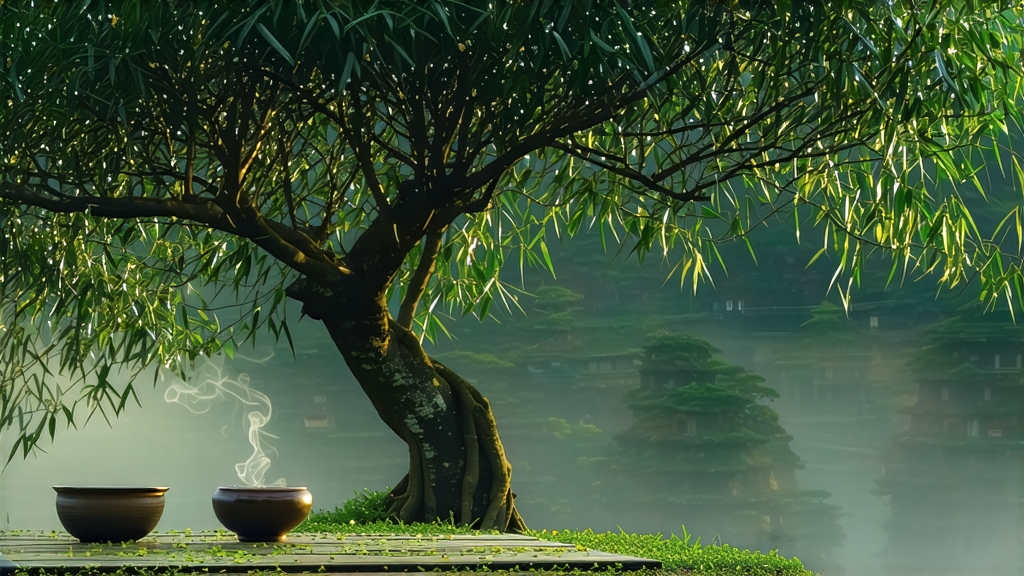
Tucked into the granite folds of Phoenix Mountain in northern Guangdong, Phoenix Dancong—literally “single-bush”—is the most perfumed and kaleidoscopic member of China’s oolong family. Unlike the territorial rock teas of Wuyi or the verdant high-mountain oolongs of Taiwan, Dancong refuses to be pinned to a single flavour. One leaf can evoke orange-blossom honey, another ripe lychee, and yet another roasted almond or fresh ginger. This chameleon-like quality has earned it the nickname “the tea that drinks like perfume,” and for more than nine centuries it has seduced poets, merchants, and emperors alike.
Historical roots
Local chronicles credit the Song imperial court with the first serious cultivation. When the young prince Zhao Bing fled south ahead of Mongol cavalry in 1278, legend says his retinue rested at Wudong village, drank an infusion from a venerable tea tree, and found the liquor so fragrant that it revived the boy’s spirits. The tree was henceforth known as Song Zhong—“Song Ancestor.” Whether apocryphal or not, the tale anchors Dancong’s pedigree in the late Song, and cores taken from the mother tree still carbon-date to roughly that era. By the Ming, the mountain’s She ethnic minority had developed the practice of selecting individual trees whose leaf chemistry produced singular aromas, grafting them vegetatively to preserve the trait. Thus the concept of “single-bush clonal tea” was born, centuries before modern horticulture.
Micro-terroir and garden ecology
Phoenix Mountain rises abruptly from the subtropical lowlands, creating a ladder of microclimates between 350 m and 1 400 m. Morning fog condenses on the granite scree, feeding mineral-rich trickles that keep the soil pH between 4.5 and 5.2—ideal for Camellia sinensis var. sinensis. The most coveted gardens sit above 800 m, where diurnal swings of 10 °C slow leaf growth, concentrating aromatic precursors. Old-growth trees, some exceeding 300 years, send roots two metres deep, mining potassium and rare earth elements that translate into cup complexity. Because the mountain is a protected watershed, no agro-chemicals are permitted; instead, leguminous cover crops and wild bamboo provide nitrogen and shade, while insect diversity keeps pests in check. The result is a living archive of flavour: roughly 80 recognised aromatic profiles grouped by villagers into ten “fragrance types,” among them honey-orchid, almond, ginger flower, gardenia, and the elusive “duck-shit” aroma that, despite its name, suggests wild narcissus.
Plucking and withering
The harvest window is brutally short: two weeks between late April and early May, when three leaves and a bud reach 70 % open. Pickers climb 200-year-old trees on bamboo ladders, laying the shoots into shallow wicker baskets lined with banana leaf to prevent bruising. At the village cooperative, the leaf is spread no thicker than 3 cm on reed mats in a naturally ventilated loft. From noon until dusk, sun-withering is interrupted every 20 minutes to toss the leaf gently in the air—a motion called “shaking green” that initiates edge bruising and triggers lipoxygenase enzymes responsible for floral volatiles. As dusk falls, the leaf is moved indoors to continue oxidation at 24 °C and 75 % humidity, conditions that coax a gradual transformation from grassy to fruity.
Oxidation and shaping
Over the next 12 hours the leaf is rested and turned six times. Oxidation is arrested at 30–35 %, lower than Wuyi rock tea but higher than Tieguanyin, preserving enough green character to lift the aromatics while developing amber depth. Once the edges turn russet and the aroma shifts from cut apple to ripe peach, the leaf is flash-heated in a 200 °C drum for 90 seconds to kill green enzymes. While still pliable, it is rolled into tight, dark ribbons using a mechanical kneader set to 45 rpm—slow enough to keep the bud intact yet fast enough to extrude juices that will caramelise later. A brief second rolling under 10 kg pressure produces the signature “dragonfly head” shape, knotty with white hairs that indicate superior withering.
Charcoal baking: the soul step
What separates Dancong from all other oolongs is its charcoal baking cycle. In a squat clay oven, lychee-wood embers are banked to a steady 80 °